Text
Prince Albert Victor recovered from his illness in early 1892 and his engagement to Princess Mary of Teck proceeded as intended. The wedding, held in July 1893 at St. George’s Chapel, Windsor Castle, was a grand affair, intended to strengthen ties within the royal family and the British Empire.

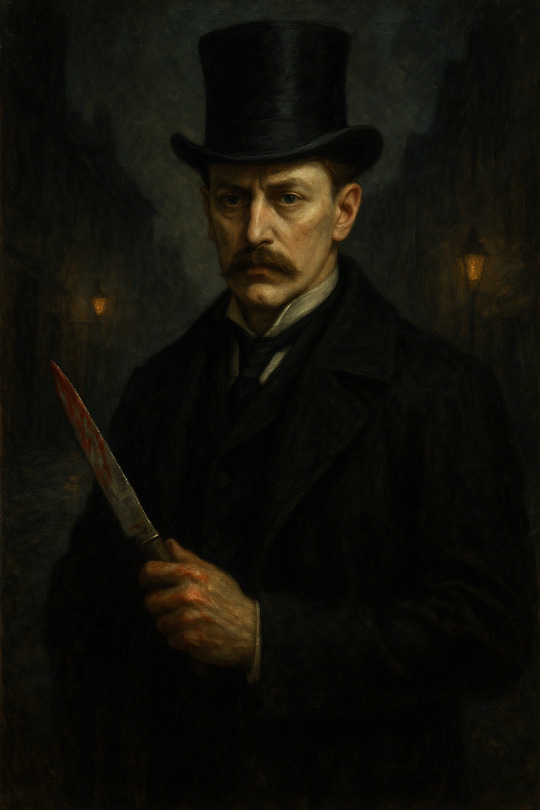
Prince Albert Victor, notoriously known now as The Blood Prince, was a somewhat enigmatic figure even in his youth. Contemporary observers described him as amiable yet impressionable, socially awkward, and prone to mysterious disappearances from court life. Police records unearthed decades later reveal that by late 1888, Sir Charles Warren, then Commissioner of the Metropolitan Police, had received credible evidence implicating a member of the royal family in the Whitechapel murders.
Documents declassified by the Republican Historical Archive in 1972, known collectively as The Blood Prince Papers, confirm that over the next four decades, a string of unsolved murders stretching from London to Balmoral, and even the Empire’s farthest reaches, bore the telltale mutilations and ritualistic marks associated with the Whitechapel Ripper.
These findings, including witness descriptions of a well-dressed man of Albert Victor’s build seen with the victims and a bloodied cloak linked to the prince’s private quarters, prompted an immediate suppression orchestrated by Lord Salisbury’s government and Queen Victoria herself.
The prime motivation was to preserve national stability and the monarchy’s sanctity.
The engagement of Prince Albert Victor to Princess Mary of Teck in 1891, long viewed as a strategic match to bolster the monarchy’s image, was marred by unspoken tensions. Letters from Mary to her confidante, Lady Charlotte Knollys, uncovered in the early 20th century, convey her growing unease at Albert Victor’s erratic temperament, nocturnal wanderings, and unexplained injuries.
Mary quickly withdrew into icy reserve, her public stoicism masking a life of surveillance, threats, and unbearable complicity.
Throughout the 1890s and early 1900s, as Albert Victor’s crimes persisted under elaborate cover-ups, Prince George and Mary of Teck drew ever closer. Both were trapped: George, as the younger brother of a monster he could not dethrone, and Mary, as the queen consort to a man she had grown to fear and despise. Their relationship, at first one of empathy, deepened into a secret love affair by the 1910s, as Albert Victor’s madness escalated and the kingdom veered toward catastrophe.
Secret memoranda between Prince George and Prime Minister H.H. Asquith outline plans to have Albert Victor quietly committed under the guise of a nervous breakdown in 1912 — a plan quashed by Queen Alexandra and the Privy Council, fearing public scandal.
George confronted his brother again in 1914 in a private meeting at Windsor. Servants later claimed to hear shouting and sounds of shattered glass. George reportedly threatened to expose the king’s crimes, only to be placed under de facto house arrest at Sandringham. From that point, their relationship was irreparable. George signed his letters “G. R.” — George Rex, a symbolic claim to the throne he believed Albert Victor had forfeited by blood.
The delicate concealment of the by then king’s crimes unraveled during the tumult of the First World War. Amid rising anti-aristocratic sentiment and widespread casualties, republican agitation intensified. Riots erupted all throughout the nation, soldiers at the front mutinied, and statues defaced. The scandal irrevocably shattered public faith in the monarchy.
When Albert Victor’s arrest came in 1916 following the Red Cross nurse’s murder at Buckingham Palace, it was George and Mary who coordinated the secret transfer of evidence to Parliament and the military. Both knew it would mean the monarchy’s end, but neither hesitated.
On March 1, 1918, the Commonwealth Republic Act formally abolished the monarchy and Albert Victor, imprisoned, died in his Tower cell the following day by his own hand.
George and Mary’s bond remained unbroken and they fled England after the abolition of the British Monarchy, living a quiet life together in Switzerland until George’s death in 1936.
Mary and George lived as discreetly as possible, their exile a mixture of quiet solace and gnawing sorrow for the nation they’d lost. They maintained a small circle of fellow British exiles, former staff, and Swiss sympathizers. For the rest of their days, they lived together unmarried, yet inseparable.
The new British Republic instituted sweeping reforms, dismantled aristocratic privilege, and repurposed royal palaces as public museums and state institutions. The memory of King Albert I was obliterated from official records, portraits destroyed, and his name reviled in folk tales.
4 notes
·
View notes
Note
how can someone who likes George V, also like someone like Edward VIII? Can you name one single redemptive quality that pathetic little man had? His supremacist view? His love of Hitler? His treatment of his youngest brother? His lack of concern for his sick father and later for his sick brother? Him chasing everything with a skirt?? His selfishness? His pettiness? His betrayal? He was repulsive!
I think you are mistaken, I do not respect David like I do George and Mary.
Overall, I agree with George and Mary's view of David's bad behavior, yet feel like David is slightly relatable in someways. He didn't want to be King, just like many today do not like their jobs, but unlikes us, him turning away from his job was also turning away from his family. I think he felt torn about this (with his selfish nature battling against his love for his family), but gradually iced out his family and overly focused on his mistress, Wallis, who was his gateway and excuse, and in a delusional state after MANY years of torment (there are letters from WWI hinting how he didn't want to be King) believed that his family were going to celebrate his abdication because he was doing it because he was in love.
I do not think David made many right decisions, but I do think he is very interesting and tragic.
10 notes
·
View notes
Text
In the long, winding history of the House of Windsor, few figures are as quietly intriguing as Lord Edward Alexander Louis Windsor, Earl of Balmoral, later 2nd Duke of Windsor.

Edward Alexander Louis Windsor was born on 27 March 1938 at Château de Candé, the Loire Valley estate where his father, the former King Edward VIII, had taken refuge following his 1936 abdication. His mother, Wallis, Duchess of Windsor — still reviled in certain court circles — gave birth to him far from the British press and public gaze. While the royal household was formally silent on the child’s arrival, privately, members of the family expressed cautious interest.
Born amid scandal and exile in 1938, Alexander — as he was known to intimates — lived a life marked by divided loyalties: the cherished only child of a fallen king and a controversial duchess, yet bound by blood to the heart of Britain’s royal house. His story is one of delicate balancing acts, familial affection strained by protocol, and a lifetime lived in history’s margins.
While Alexander’s relationship with his parents was affectionate in moments, it was constrained by the formality of the times and his parents’ own limitations. Wallis was proud of his poise and appearance but rarely allowed emotional intimacy. His father, though fonder, struggled to engage meaningfully, burdened by the weight of his abdication and personal regrets.
Despite the bitter rupture caused by the abdication, Lord Alexander spent many of his formative holidays at Sandringham and occasionally Balmoral. It was an arrangement born of duty, compassion, and a tacit understanding that the boy should know his heritage, however complicated.
Contemporary letters from courtiers record the Dowager Queen Mary’s fondness for the boy, noting his “delicate manners, bright disposition, and curious likeness to his grandfather, George V, in his profile.” It was at these gatherings that Alexander came to know his uncles — King George VI, the Duke of Gloucester, and the Duke of Kent — and his cousins, including the future Queen Elizabeth II and Princess Margaret. Though outwardly treated as one of their own, there remained an unspoken divide. His mother’s American lineage and divorce remained a silent barrier.
In public, the royal family never formally acknowledged Alexander in state functions or the line of succession, nor was his name listed in official Court Circulars. Yet within private correspondence, his presence is frequently mentioned. King George VI, though personally wounded by his brother’s abdication, is said to have found the boy engaging, and photographs survive of Alexander with the royal cousins during postwar times.
He pursued an academic career, studying Art History at the Sorbonne and later serving as a curator in Paris. His lifelong friendship with Lord Louis Mountbatten provided him with occasional entrée to Anglo-royal society, though never without its tensions. Mountbatten reportedly sought to broker a quiet reconciliation between Alexander and Queen Elizabeth II in the late 1960s, but while letters exchanged between the Queen and Alexander remain courteous and kind, no formal restoration of status ever occurred.
Upon his father’s death in 1972, Alexander inherited the Dukedom of Windsor, becoming the 2nd Duke of Windsor. It was a hollow inheritance; the title carried no territorial lands or official duties and was regarded by the British court as an unmentionable curiosity.
The Queen extended no formal acknowledgment of his new rank. Alexander declined to press his claim to HRH status, preferring instead to live quietly between Paris and the French Riviera, occasionally attending select society gatherings under the title of His Grace, the Duke of Windsor.
While much of his life was marked by quiet diplomacy between familial ties and public discretion, his private life too was one lived carefully in the margins. In an era when homosexuality remained illegal in Britain until 1967 and deeply stigmatized in both aristocratic and royal circles long thereafter, Alexander navigated his identity with tact and profound caution. It is now widely accepted among contemporary historians that Alexander was gay.
Alexander shared his life with a number of men, including Julien d’Aubigny, a French-born art dealer and restorer. The two men met in Paris in the early 1960s during Alexander’s tenure at the Musée Jacquemart-André, and their partnership, while discreet in public, was deeply devoted in private. Though British tabloids occasionally hinted at “the Duke’s elusive companion,” no public scandal ever erupted.
The final chapter of Alexander’s life was shadowed by tragedy familiar to many of his generation within the gay community. In the early 1990s, he had complications related to AIDS, then still a condition marked by stigma and limited treatment options.
Those close to him recalled his dignity and good humor in the face of illness. It was said that members of the royal family, though unable to act openly, sent private messages of sympathy. Alexander died in 1995 at age 57. His funeral at Frogmore was a modest, private affair. The Dukedom of Windsor became extinct upon his death, bringing a quiet end to the title born of Edward VIII’s abdication.
#fake history#what if…?#edward viii#duke of windsor#wallis simpson#queen mary#george v#king george vi
5 notes
·
View notes
Text

“In the ruins of two empires, a promise still lingers.”
...
Introducing an alternate history fanfiction — Throne and Ashes.
What if Grand Duchess Olga Romanov had survived the Russian Revolution
Not by chance but through a marriage arranged in silence, with the heir to the British throne - Edward "David", Prince of Wales
This is a slow-burn alternate history about survival, memory and the quiet, stubborn act of staying alive.
If you’re drawn to bittersweet love stories, reimagined histories, or characters who hold each other gently through the dark, this may be your kind of tale!
LINK: https://www.wattpad.com/1534762880?utm_source=ios&utm_medium=link&utm_content=share_reading&wp_page=reading&wp_uname=EvelynnHorned
#oh snap#reblogging this bc apparently op here had the same idea as me#wow cool#though this is more romanticized whereas mine is very much *not*
13 notes
·
View notes
Text
Creating a “What if…?” reality where Edward VIII and Grand Duchess Olga were forced into an arranged marriage to strengthen ties between the two countries before the outbreak of war
(based on an offhanded comment I read about Queen Victoria thinking the pair would make a nice arrangement)

Olga Nikolaevna married Edward, Prince of Wales, in 1913 to strengthen the Anglo-Russian alliance on the eve of the First World War. Their marriage was loveless, contentious, and increasingly scandalous.
Edward, then a rakish 19-year-old, was famously opposed to dynastic duties and wary of his restrictive royal role. Olga, barely 18, had little say. Deeply sheltered and still grieving the deaths of several relatives, she was thrust into the engagement to appease her father’s advisors and to fortify monarchist solidarity.
The pair were married in a hastily arranged but glittering ceremony at St. Paul’s Cathedral in London in November 1913, attended by much of Europe’s ruling elite — including Kaiser Wilhelm II and Archduke Franz Ferdinand. Court observers noted Edward’s dour expression and Olga’s visible distress throughout.
When World War I erupted in 1914, the marriage became a political lightning rod. Edward, openly sympathetic to Germany owing to his close familial ties with the Hohenzollerns, scandalized the British court by opposing Britain’s declaration of war.
Olga, conversely, was a fervent supporter of the Allied cause and deeply loyal to her homeland. She threw herself into war relief work and was often seen visiting wounded soldiers, earning genuine public admiration. The marriage quickly deteriorated as the couple found themselves on opposite sides of a growing ideological and emotional chasm.
By 1915, Edward had begun an affair with an older British socialite, Lady Venetia Stanley, while Olga immersed herself in hospital work, even allegedly carrying on a discreet relationship with a wounded Russian officer stationed in Britain.
Their only child, Princess Maria Alexandra Victoria Mary of Wales, was born on March 18, 1916 at Windsor Castle.
The birth was overshadowed by tensions between the couple and mounting war losses on both the British and Russian sides. Named in honor of both her Romanov grandmother Alexandra Feodorovna and Queen Victoria, Maria Alexandra became a symbol of royal continuity in a Europe torn by revolution and war.
When Tsar Nicholas II and his family were executed in 1918, Olga suffered a mental and emotional collapse, while Edward reportedly showed indifference, focusing on his growing collection of mistresses.
As Edward’s scandalous lifestyle and pro-German sympathies worsened in the 1920s and 30s, Olga devoted herself to raising Maria Alexandra with a strict, old-world sense of duty and monarchic responsibility. The young princess was fluent in Russian, English, French, and German by age 10, and showed early signs of a sharp political mind — a necessity given the increasingly unstable royal household.
When King George V died in 1936, Edward became Edward VIII — and almost immediately plunged the monarchy into crisis with his insistence on keeping his American mistress, Wallis Simpson.
In this timeline, rather than abdicating, Edward forced through a compromise with the government: he remained king, while Wallis was exiled to France. Publicly humiliated and politically marginalized, Olga relocated with Princess Maria Alexandra to Balmoral, shielding her daughter from the worsening scandal.
After a series of pro-German remarks and secret communications with Nazi officials in 1940, Edward was forced by Winston Churchill and Parliament to abdicate in 1941, leading his young daughter, Princess Maria Alexandra, to ascend the throne.
At 25, Queen Maria Alexandra was the youngest woman to assume the British throne since Queen Victoria. Her reign was immediately overshadowed by the scandals of her father and the devastation of World War II.
Winston Churchill remained as Prime Minister and became Maria Alexandra’s mentor and protector, helping to shield her from lingering public resentment toward her father.
During the war, she became a beloved figure for her tireless hospital visits, radio addresses, and passionate speeches denouncing fascism, which earned her respect across Allied nations.
Her reign faced consistent controversy over her Romanov heritage, pro-Russian sympathies, and her father’s treachery. MI5 files released in the 1970s revealed that British intelligence continued monitoring the queen’s personal communications for possible subversive contacts well into the 1960s.
Her mother, Olga Nikolaevna, died in 1971 in Switzerland — estranged from both Edward and much of the British royal court. Her father, Edward VIII, died in 1975, denied a state funeral.
4 notes
·
View notes
Text

"Once I happened to be with the Queen, when she was visiting a hospital for children. Suddenly she stopped at a cot, saying: “Oh, how like my little Johnnie he is!” and there were tears in her eyes. Tenderly she went up and kissed the little boy. That was the only sign I ever saw her give of an ever-present anxiety about the little Prince. He had a decided talent for drawing, and loved gardening. His little garden at Wood Farm was always beautifully kept, and often when he wrote to his parents he would enclose a pressed pansy. Once a really lovely rose came out on his rose-tree. “Mummie must have this alive,” he said to his nurse, and accordingly it was cut, packed carefully in a box, and sent to Queen Mary, who wore it for three days, and then kept it in a little vase in her own room"
62 notes
·
View notes
Text

Baby Prince William of Gloucester playing with the shoes of his grandmother Queen Mary, who has captioned the photos “William playing with my shoes!” (from Queen Mary’s Photograph Albums, edited by Christopher Warwick)
49 notes
·
View notes
Note
Favourite biography of Queen Mary?
hey sorry for the long wait, I haven’t been on this blog in a while and im just seeing this
Idk about favorite, this is the one I last read but that was a while ago. I haven’t been reading a whole lot of brf biographies lately
3 notes
·
View notes
Text

source

#mary of teck#queen mary#george v#king george v#brf#british royal family#not me being giddy over this comment they are sooo cute!!!
11 notes
·
View notes
Text
"Queen Mary was stern and cold"
Queen Mary:
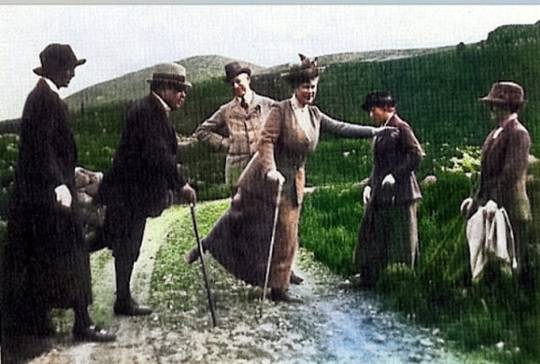
62 notes
·
View notes
Text
'I can never sufficiently express my deep gratitude to you, darling May, for the way you have helped and stood by me in these difficult times. This is not sentimental rubbish, but what I really feel.'
George to May on the 20th anniversary of his accession to throne
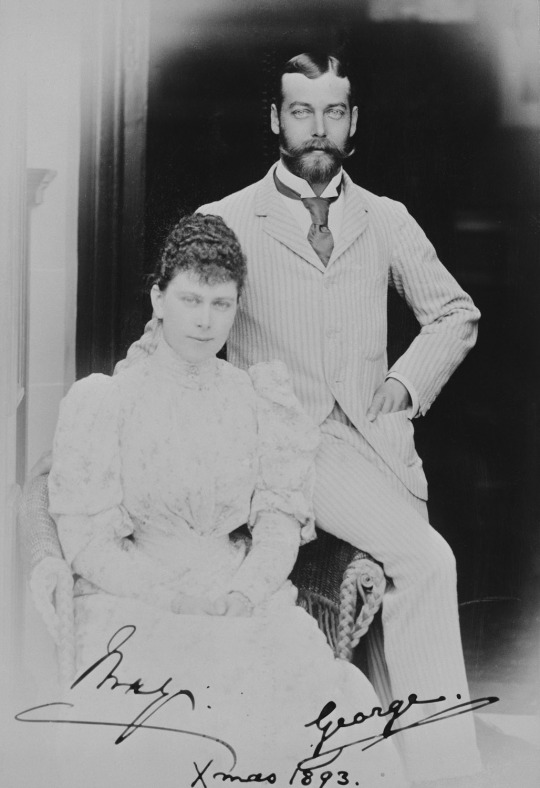

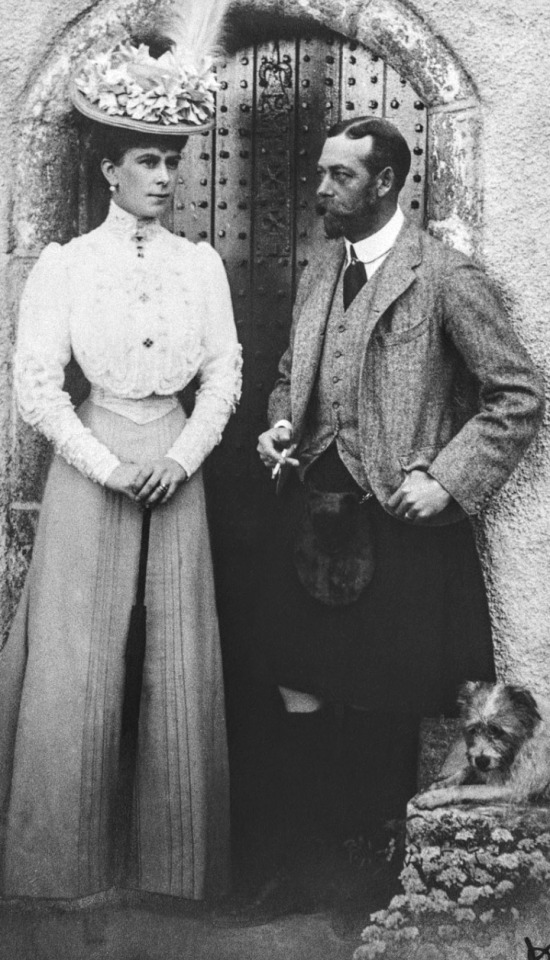
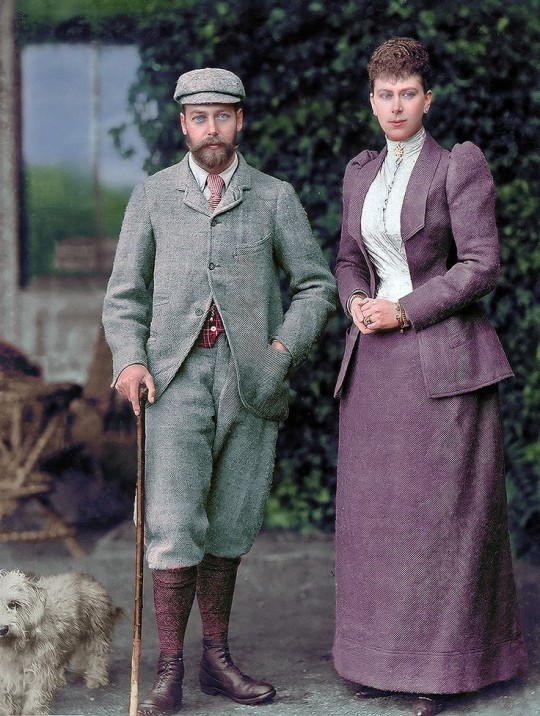

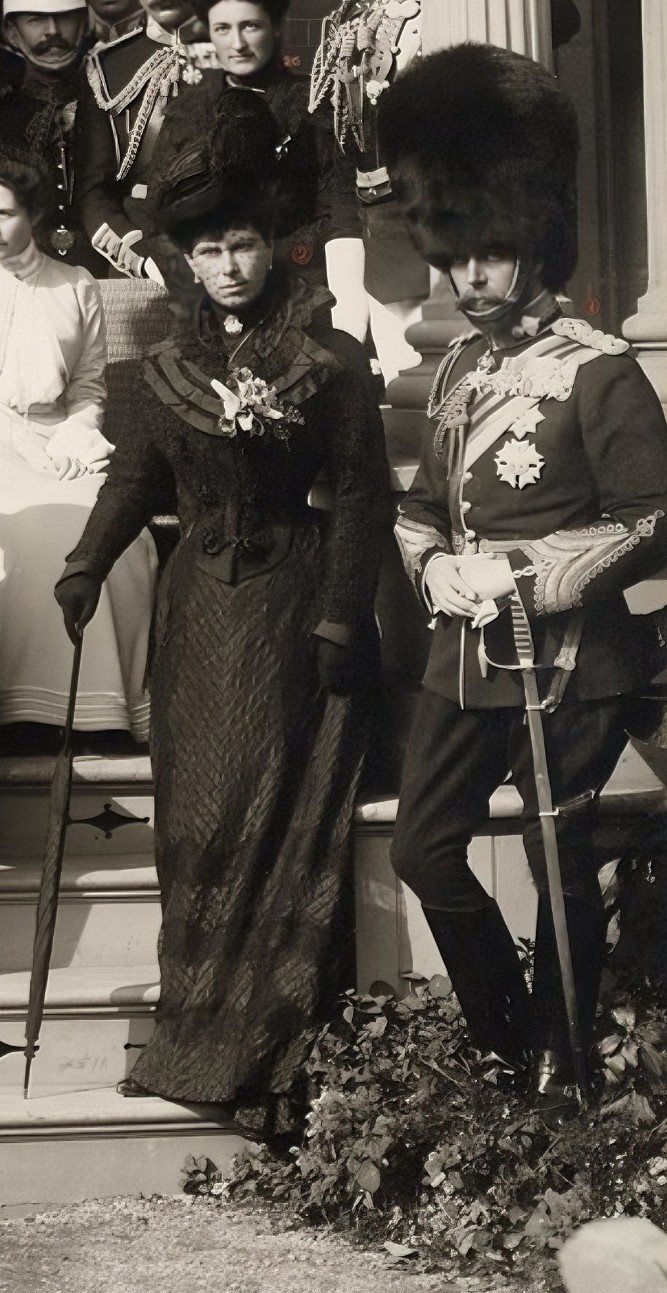

The Power Couple 💞
"Love is an action word"
127 notes
·
View notes
Text

Baby plays with Queen Mary's umbrella
69 notes
·
View notes
Text

Princess Mary and prince John circa 1912
28 notes
·
View notes
Text
King George V and Queen Mary (1923) digitally restored
youtube
9 notes
·
View notes
Text
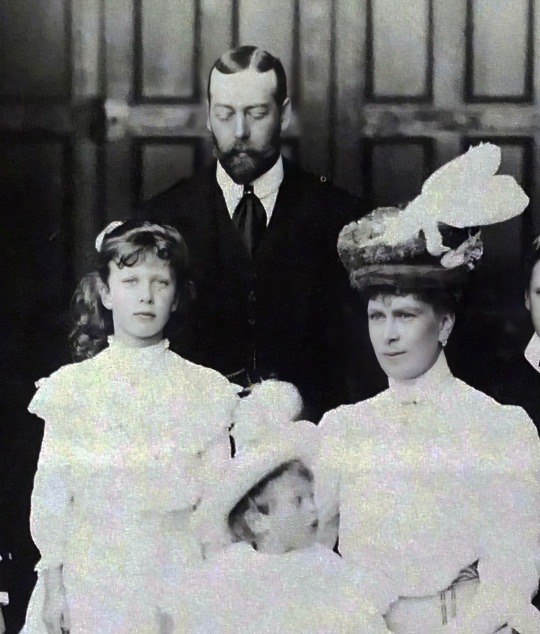
George V letter to his 'little butterfly' as he called his daughter Mary, 1905.”
“I was delighted to get your letter this morning…Your French is beautiful and your writing much improved. I am also pleased to hear that Mademoiselle is quite satisfied with you and that you are getting on well with your lessons…I am sure you could easily beat me at golf now as you have been playing so much lately.”
89 notes
·
View notes
Text
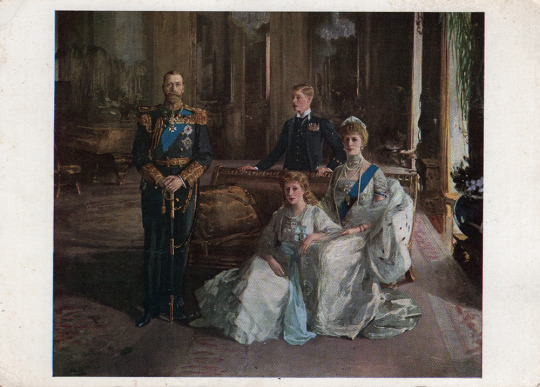
King George V with his wife, eldest son, and only daughter.
129 notes
·
View notes
Text
Colorized footage of the moment George V lifts little princess Margaret, aged 4, over the balcony of Buckingham Palace, at the wedding of duke of Kent with princess Marina, 1934
224 notes
·
View notes